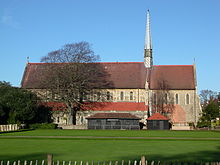St John the Evangelist's Church, Preston, Brighton
| St John the Evangelist's Church | |
|---|---|

The church from the south
|
|
| 50°50′40″N 0°09′03″W / 50.8445°N 0.1509°WCoordinates: 50°50′40″N 0°09′03″W / 50.8445°N 0.1509°W | |
| Location | Knoyle Road/Preston Road, Preston Village, Brighton and Hove BN1 6RB |
| Country | United Kingdom |
| Denomination | Anglican |
| Website | www.brightonstjohn.org.uk/ |
| History | |
| Founded | 16 October 1901 |
| Dedication | John the Evangelist |
| Dedicated | 26 October 1902 |
| Architecture | |
| Status | Active |
| Functional status | Parish church |
| Heritage designation | Grade II listed |
| Designated | 26 August 1999 |
| Architect(s) | Arthur Blomfield |
| Style | Early English Revival |
| Groundbreaking | June 1901 |
| Completed | 1926 |
| Specifications | |
| Capacity | 800 |
| Administration | |
| Parish | Preston, St John with St Augustine and St Saviour |
| Deanery | Rural Deanery of Brighton |
| Archdeaconry | Chichester |
| Diocese | Chichester |
| Province | Canterbury |
St John the Evangelist's Church is an Anglican church in the Preston Village area of Brighton, in the English city of Brighton and Hove. The Grade II listed building, designed by Sir Arthur Blomfield, was started in 1901 but did not take its present form for another quarter of a century. In the meantime, the nearby parish church of Preston was severely damaged by fire, and the new church was granted the parish church status which it still retains.
The village of Preston was established on a downland site 1.5 miles (2.4 km) north-northwest of Brighton before the time of the Domesday Book.St Peter's Church was its original parish church. No trace remains of the building mentioned in the Domesday Book: it was rebuilt in about 1260 in flint with a chancel, nave and tower. The village, based around a crossroads and a manor house, Preston Manor, became part of the Borough of Brighton on 31 October 1873.
The Stanford family, who owned most of the land in the area, sold it for residential development in the mid-1860s. Rapid growth ensued, and the old church became inadequate for the increasing population. In 1899, the new vicar proposed extending the church, but the church council and local people felt that altering the ancient building would be inappropriate. Instead, the decision was taken to build a new church on land occupied by the garden of the vicarage.
Work began quickly: the site, at the junction of Preston Road and Knoyle Road, was prepared in the summer of 1901, and the Bishop of Chichester Ernest Roland Wilberforce laid the foundation stone on 16 October 1901. Sir Arthur Blomfield designed the church, and the Crawley-based building firm of James Longley built it. Construction work continued into the next year; the church officially opened after it was dedicated on 26 October 1902.
...
Wikipedia
